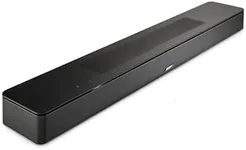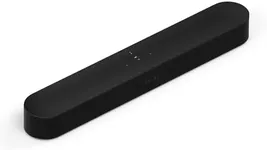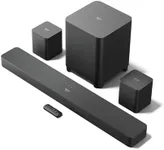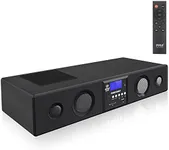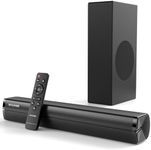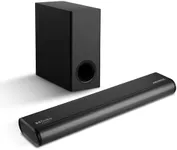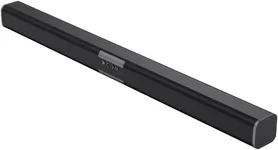Buying Guide for the Best Sound Bars
Choosing the right sound bar can significantly enhance your audio experience, whether you're watching movies, playing games, or listening to music. Sound bars are designed to provide better sound quality than your TV's built-in speakers, and they come in various sizes and configurations to suit different needs. To make an informed decision, it's important to understand the key specifications and how they relate to your personal preferences and usage scenarios.Audio ChannelsAudio channels refer to the number of separate audio signals the sound bar can produce. Common configurations include 2.0, 2.1, 3.1, 5.1, and even 7.1 channels. A 2.0 sound bar has two channels (left and right), while a 2.1 adds a subwoofer for enhanced bass. Higher numbers like 5.1 and 7.1 include additional speakers for surround sound. If you want a more immersive experience, especially for movies and gaming, opt for a higher channel count. For general TV watching and music, a 2.0 or 2.1 might suffice.
Connectivity OptionsConnectivity options determine how you can connect the sound bar to your TV and other devices. Common connections include HDMI ARC, optical, Bluetooth, and Wi-Fi. HDMI ARC provides high-quality audio and allows control through your TV remote, making it a convenient choice. Optical connections are also good for high-quality sound but lack some of the convenience features of HDMI ARC. Bluetooth and Wi-Fi enable wireless streaming from smartphones and other devices. Consider what devices you plan to connect and choose a sound bar with the appropriate connectivity options.
Size and DesignThe size and design of the sound bar can affect both its performance and how well it fits into your living space. Larger sound bars generally offer better sound quality due to bigger speakers and more room for sound to travel. However, they also take up more space. Slim and compact designs are ideal for smaller rooms or if you prefer a minimalist look. Measure the space where you plan to place the sound bar and consider the aesthetics of your room to find a model that fits well.
SubwooferA subwoofer is a speaker dedicated to reproducing low-frequency sounds, adding depth and richness to the audio. Some sound bars come with built-in subwoofers, while others include separate, often wireless, subwoofers. If you enjoy bass-heavy music or want to feel the rumble of explosions in movies, a sound bar with a subwoofer is a good choice. For more balanced audio or if space is limited, a sound bar without a subwoofer might be sufficient.
Smart FeaturesSmart features in sound bars include voice assistants like Alexa or Google Assistant, app control, and integration with smart home systems. These features can add convenience, allowing you to control the sound bar with voice commands or through an app on your phone. If you already use smart home devices or want to streamline your entertainment setup, look for a sound bar with these capabilities. If you prefer a straightforward audio experience, you might not need these extras.
Sound QualitySound quality is arguably the most important aspect of a sound bar. It encompasses clarity, balance, and the ability to reproduce a wide range of frequencies. Look for sound bars with good reviews on sound quality, and consider features like Dolby Atmos or DTS:X for a more immersive experience. If you're an audiophile or plan to use the sound bar for high-quality music listening, prioritize models known for excellent sound quality. For casual TV watching, a mid-range sound bar should suffice.





